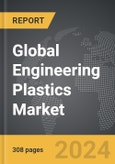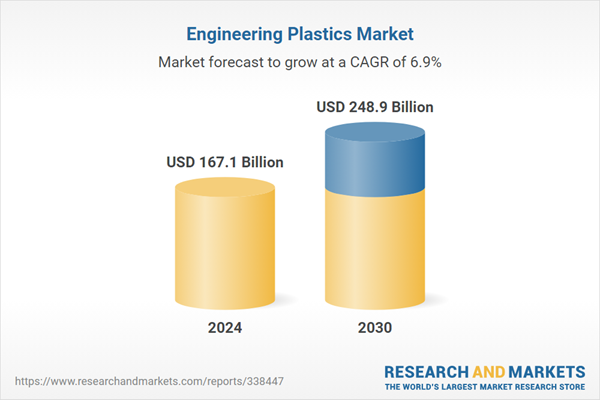The global market for Engineering Plastics was valued at US$167.1 Billion in 2024 and is projected to reach US$248.9 Billion by 2030, growing at a CAGR of 6.9% from 2024 to 2030. This comprehensive report provides an in-depth analysis of market trends, drivers, and forecasts, helping you make informed business decisions.
Global Engineering Plastics Market - Key Trends and Drivers Summarized
What Are Engineering Plastics, and How Are They Shaping Modern Industries?
Engineering plastics are a class of plastics that are used in high-performance applications due to their superior strength, thermal stability, and chemical resistance compared to commodity plastics. Unlike standard plastics, engineering plastics can withstand harsh environments and mechanical stresses, which makes them ideal for use in automotive, aerospace, electronics, and industrial machinery. Some common types of engineering plastics include polyamides (nylon), polycarbonates, polyacetals, and thermoplastic polyesters. These materials are characterized by their ability to maintain integrity under high temperatures, loads, and prolonged exposure to chemicals. They are also favored for their versatility in manufacturing processes such as injection molding, CNC machining, and 3D printing, allowing for the creation of complex shapes and high precision parts.How Have Advances in Technology Enhanced the Properties and Uses of Engineering Plastics?
Recent technological advancements have significantly enhanced the properties of engineering plastics, making them more integral to various high-tech applications. Innovations in polymer science have led to the development of blends and composites that exhibit improved heat resistance, greater mechanical strength, and enhanced optical clarity. For instance, the introduction of fiber reinforcements like glass and carbon fibers has resulted in materials that are much lighter yet stronger than some metals, which is a crucial attribute in the aerospace and automotive sectors. Additionally, advancements in additive manufacturing have allowed for the direct printing of parts using engineering plastics, which has revolutionized the prototype development phase by reducing time and costs associated with traditional manufacturing methods.What Impact Does the Use of Engineering Plastics Have on Sustainability and Environmental Conservation?
The use of engineering plastics also plays a significant role in environmental conservation and sustainability. These materials are increasingly designed to be recyclable or to have a lower environmental impact during production and disposal. For example, bio-based engineering plastics are being developed from renewable resources, which reduce dependency on fossil fuels and decrease carbon emissions. Furthermore, the lightweight nature of these plastics leads to more fuel-efficient vehicles when used in automotive manufacturing, significantly lowering the environmental footprint. The durability and longevity of engineering plastics also mean that products have longer life cycles, reducing the need for frequent replacements and minimizing waste.What Drives the Growth of the Engineering Plastics Market?
The growth in the engineering plastics market is driven by several factors, including innovations in material science, increased demand from end-use industries, and shifting consumer behaviors. As industries push for lighter, more durable materials to enhance product performance and energy efficiency, the demand for engineering plastics continues to rise. Specifically, the automotive sector seeks to reduce vehicle weight to comply with stringent global emissions standards, driving substantial growth in the engineering plastics sector. Additionally, the rapid expansion of the electronics industry requires plastics that can withstand high temperatures and electrical stresses, further boosting the market. Consumer behavior also plays a critical role; as more consumers demand durable and sustainable products, manufacturers turn to engineering plastics to meet these expectations. Finally, regulatory pressures and incentives for reducing environmental impact continue to push the adoption of advanced, sustainable materials like engineering plastics across various sectors.Report Scope
The report analyzes the Engineering Plastics market, presented in terms of market value (US$ Thousand). The analysis covers the key segments and geographic regions outlined below.Segments
Product Segment (Acrylonitrile-Butadiene-Styrene (ABS), Polyamide, Fluoropolymer, Thermoplastic Polyesters (PBT / PET), Other Product Segments); End-Use (Automotive, Building & Construction, Consumer Goods, Other End-Uses).Geographic Regions/Countries
World; United States; Canada; Japan; China; Europe (France; Germany; Italy; United Kingdom; Spain; Russia; and Rest of Europe); Asia-Pacific (Australia; India; South Korea; and Rest of Asia-Pacific); Latin America (Argentina; Brazil; Mexico; and Rest of Latin America); Middle East (Iran; Israel; Saudi Arabia; United Arab Emirates; and Rest of Middle East); and Africa.Key Insights:
- Market Growth: Understand the significant growth trajectory of the Acrylonitrile-Butadiene-Styrene (ABS) segment, which is expected to reach US$93.6 Billion by 2030 with a CAGR of a 7.2%. The Polyamide segment is also set to grow at 6.3% CAGR over the analysis period.
- Regional Analysis: Gain insights into the U.S. market, valued at $43.6 Billion in 2024, and China, forecasted to grow at an impressive 10.1% CAGR to reach $58.3 Billion by 2030. Discover growth trends in other key regions, including Japan, Canada, Germany, and the Asia-Pacific.
Report Features:
- Comprehensive Market Data: Independent analysis of annual sales and market forecasts in US$ Million from 2024 to 2030.
- In-Depth Regional Analysis: Detailed insights into key markets, including the U.S., China, Japan, Canada, Europe, Asia-Pacific, Latin America, Middle East, and Africa.
- Company Profiles: Coverage of major players such as BASF SE, Celanese Corp., Chi Mei Corp., Continental Structural Plastics Inc., Covestro AG and more.
- Complimentary Updates: Receive free report updates for one year to keep you informed of the latest market developments.
Why You Should Buy This Report:
- Detailed Market Analysis: Access a thorough analysis of the Global Engineering Plastics Market, covering all major geographic regions and market segments.
- Competitive Insights: Get an overview of the competitive landscape, including the market presence of major players across different geographies.
- Future Trends and Drivers: Understand the key trends and drivers shaping the future of the Global Engineering Plastics Market.
- Actionable Insights: Benefit from actionable insights that can help you identify new revenue opportunities and make strategic business decisions.
Key Questions Answered:
- How is the Global Engineering Plastics Market expected to evolve by 2030?
- What are the main drivers and restraints affecting the market?
- Which market segments will grow the most over the forecast period?
- How will market shares for different regions and segments change by 2030?
- Who are the leading players in the market, and what are their prospects?
Some of the 112 major companies featured in this Engineering Plastics market report include:
- BASF SE
- Celanese Corp.
- Chi Mei Corp.
- Continental Structural Plastics Inc.
- Covestro AG
- Dow Inc.
- Eastman Chemicals Company
- Evonik Industries AG
- Formosa Plastics Corp.
- Honeywell International, Inc.
- Huntsman Corp.
- Lanxess AG
- LG Chem
- Polyplastics Co., Ltd.
- Radici Partecipazioni SpA
- Royal DSM N.V.
- SABIC
- Teijin Ltd.
- Toray Industries Inc.
- WinTech Polymer Ltd.
Table of Contents
I. METHODOLOGYII. EXECUTIVE SUMMARY2. FOCUS ON SELECT PLAYERSIII. MARKET ANALYSISCANADAITALYSPAINRUSSIAREST OF EUROPESOUTH KOREAREST OF ASIA-PACIFICARGENTINABRAZILMEXICOREST OF LATIN AMERICAIRANISRAELSAUDI ARABIAUNITED ARAB EMIRATESREST OF MIDDLE EASTIV. COMPETITION
1. MARKET OVERVIEW
3. MARKET TRENDS & DRIVERS
4. GLOBAL MARKET PERSPECTIVE
UNITED STATES
JAPAN
CHINA
EUROPE
FRANCE
GERMANY
UNITED KINGDOM
ASIA-PACIFIC
AUSTRALIA
INDIA
LATIN AMERICA
MIDDLE EAST
AFRICA
Companies Mentioned (Partial List)
A selection of companies mentioned in this report includes, but is not limited to:
- BASF SE
- Celanese Corp.
- Chi Mei Corp.
- Continental Structural Plastics Inc.
- Covestro AG
- Dow Inc.
- Eastman Chemicals Company
- Evonik Industries AG
- Formosa Plastics Corp.
- Honeywell International, Inc.
- Huntsman Corp.
- Lanxess AG
- LG Chem
- Polyplastics Co., Ltd.
- Radici Partecipazioni SpA
- Royal DSM N.V.
- SABIC
- Teijin Ltd.
- Toray Industries Inc.
- WinTech Polymer Ltd.
Table Information
| Report Attribute | Details |
|---|---|
| No. of Pages | 308 |
| Published | April 2025 |
| Forecast Period | 2024 - 2030 |
| Estimated Market Value ( USD | $ 167.1 Billion |
| Forecasted Market Value ( USD | $ 248.9 Billion |
| Compound Annual Growth Rate | 6.9% |
| Regions Covered | Global |









